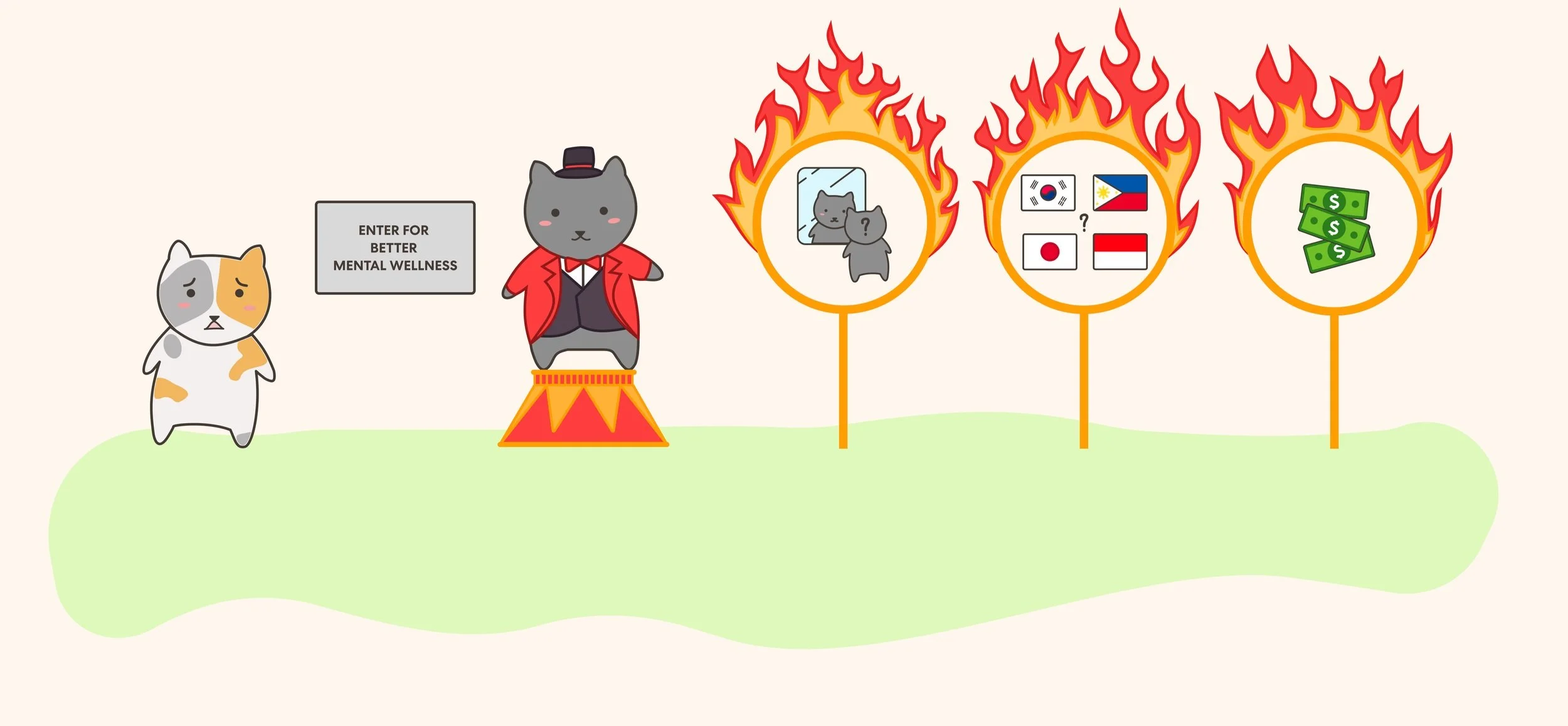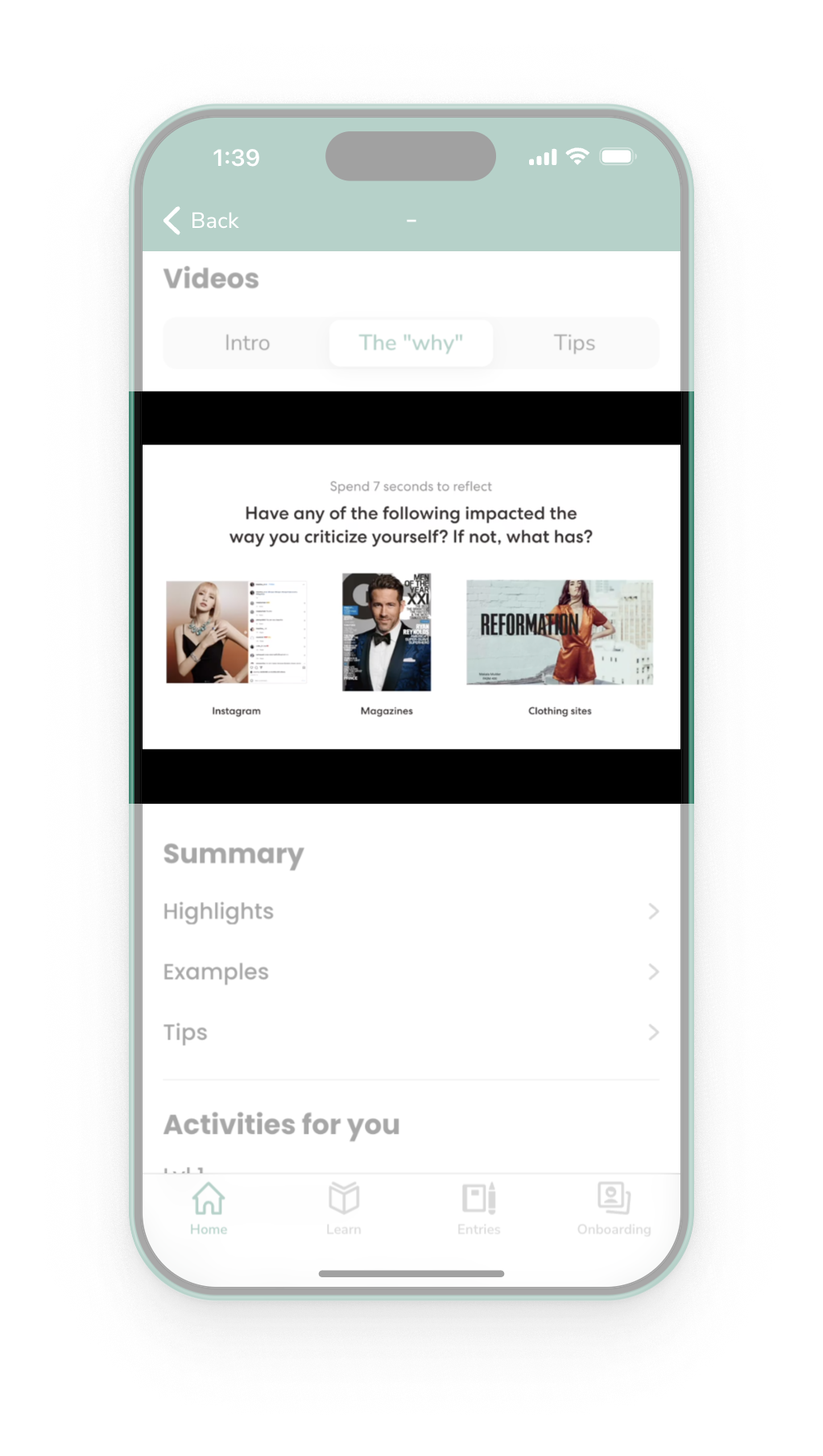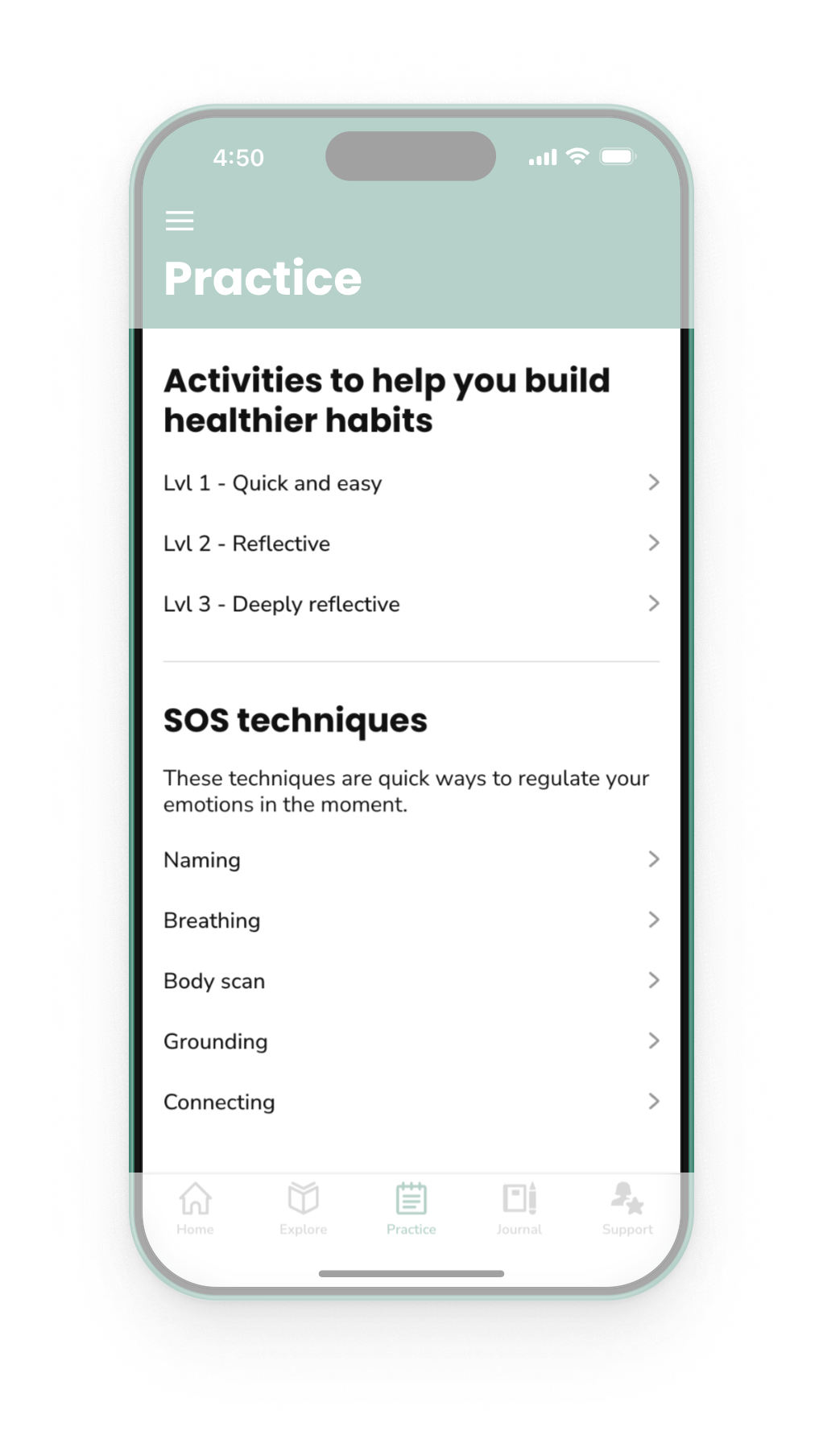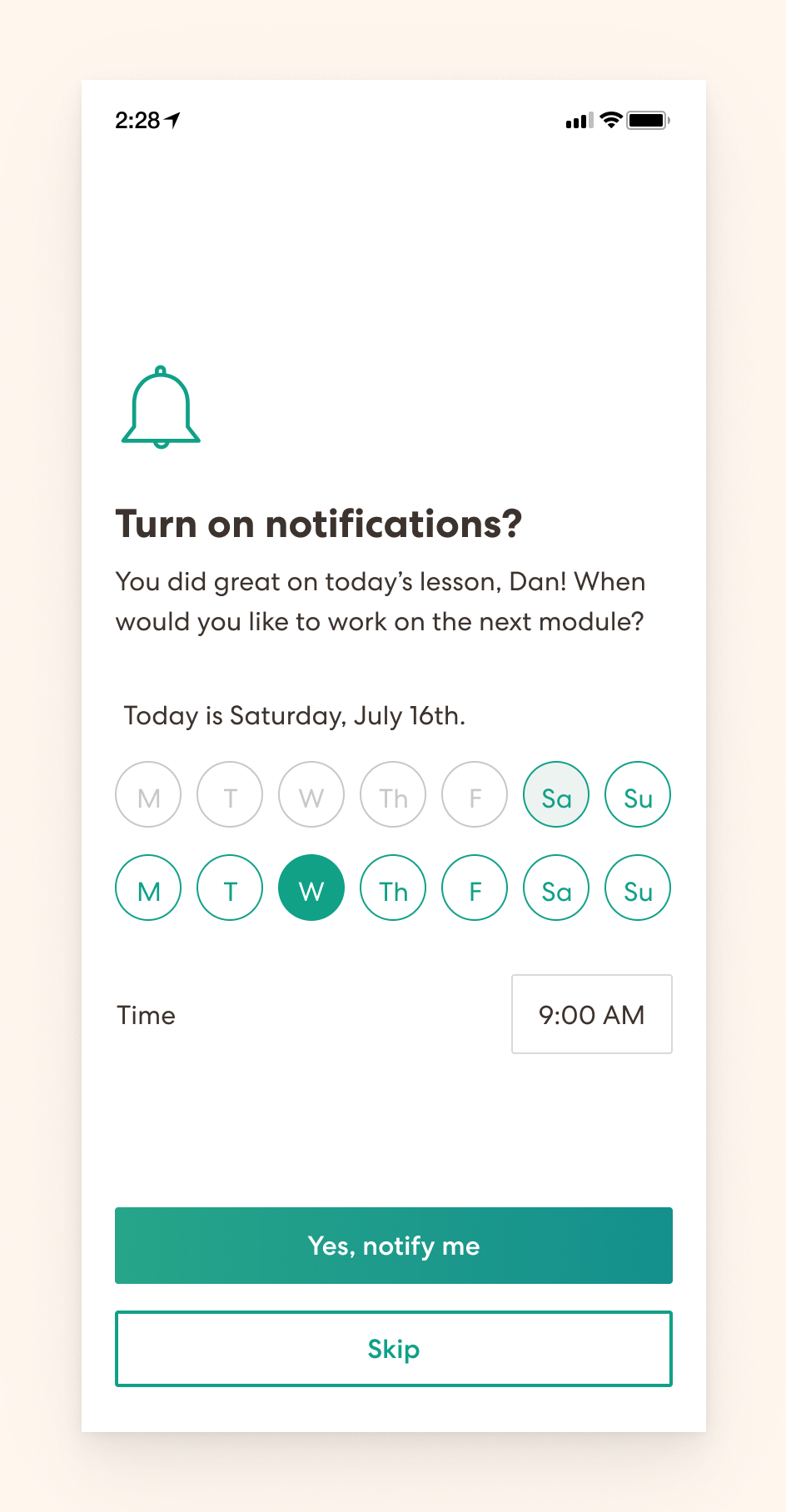Empathie: Empowering Asian Americans with Culturally Specific Mental Wellness Education
Jennifer Wong, co-founder of Empathie, approached me to establish a mental wellness app geared towards Asian Americans. As a strong advocate for mental health and accessibility, I designed and helped ship multiple iterations of the private beta. I worked cross-functionally with therapists, engineers, and other designers to establish an extensible, solid foundation with a vision for the future. Empathie helped fuel and underscore my desire to work within the field of social impact.
Role
Product Designer
Timeline
January ‘22 - November ‘22
Core Responsibilities
User research, product strategy, visual design
Problem
Asian Americans experience stress and feel unbalanced in their everyday lives, and feel disempowered to effectively manage their feelings
Asian Americans grapple with stress due to the clash between cultural heritage and societal demands, compounded by the stigma around discussing mental health. Other hurdles Asian Americans face in seeking mental wellness help include limited awareness of mental health concerns, difficulty finding culturally appropriate mental health professionals, and the potential financial costs associated with improving mental wellness. Having to jump through so many hoops to feel understood and receive help results in Asian Americans feeling disempowered and emotionally isolated while navigating their everyday lives.
Goal
Define a robust MVP that provides relevant, actionable, and accessible mental wellness education for Asian Americans with ample space to grow and excite in future iterations
It was necessary to first get signal to build the foundation for an app that would best address the hoops Asian Americans need to jump through to better their mental wellbeing. After defining the MVP, we needed to make sure we could build beyond the essentials of the app and, leveraging our learnings, design an exciting vision for the future.
Research
Asian Americans struggle to navigate negative life situations and feel unhappy because they are unable to find the right resources to help them
To further bolster the literature and our lived experiences as Asian Americans, I conducted 20 user interviews to get a better idea of what people in our demographic were struggling with in their everyday lives and what was keeping them from improving those aspects. We elucidated four main pain points:
Individuals lack awareness of the unhealthy patterns and behaviors that impact their mental wellness
Mental wellness advice lacks cultural relevance and practical application to an individual’s life situations
Online resources lack credibility, which makes individuals hesitant to utilize these resources
Improving mental wellness requires a cumbersome amount of effort due to time and affordability
Glide, the no code provider, had limited UI and functionality but allowed for agile testing
To address the pain points we found in our generative research, we designed the app around short, educational videos to help increase awareness of unhealthy patterns and behaviors relevant to common Asian American experiences, created by licensed Asian American therapists and psychologists.
Establishing a Foundation: Investigating Product Market Fit
Our team leveraged a no-code mobile app, despite technical and design limitations, to test our designs
We brainstormed on how to address the pain points between Asian Americans and mental wellness. However, we lacked the time and resources to be able to rapidly test our designs with a full app. We leveraged Glide, a no code app builder, to simulate the designs we had in mind to quickly gain feedback and get more accurate product market fit.
Investigation - Proof of Concept (POC) 1
Users felt that the topics were heavy and cumbersome to reflect on, not concise, and wanted to have more autonomy.
Users tested the proof of concept beta for a week to gain familiarity with the app and simulate real life usage. I created the pre- and post-testing surveys and conducted user interviews with Jennifer Wong (co-founder and design lead @ Empathie). We found the following pain points:
Topics were heavy and cumbersome:
Users felt overwhelmed and exhausted by the topics presented, which typically required deep emotional reflection.
Information was not concise:
Although we aimed for videos to be under five minutes, this still felt too long for users.
More autonomy:
Users felt as though it was difficult to choose what they wanted to do in the app a la carte, especially if they felt like they already had foundational knowledge in a particular topic.
Investigation - POC 2
Users want personalized, guided, and engaging content that is clear in purpose and involves accountability
In order to address the pain points of the previous iteration, we included easier-to-do activities like daily intentions, daily check ins, and more “level 1” activities. We also broke up videos into three different parts: the introduction, the “why”, and tips for applying their newfound knowledge. Additionally, we included “gamified” screens and a “plant friend” nourished by completing tasks as a rudimentary game system and a proxy for interactivity due to the limitations of the Glide app.
I also revised and created more extensive pre- and post-testing surveys. After conducting user interviews, we found the following pain points:
Modules were not engaging or personalized:
Users expected more interaction than the gamified screens, which felt too passive. The content did not seem specific to the users which was less engaging.
Unguided experience:
Some users found the page's many choices overwhelming and preferred step-by-step guidance.
Gaining points by completing actions in the app to “nourish” their plant friend was the main form of feedback in this iteration
Unclear purpose:
Some users were unsure about the purpose of certain mental health activities, like daily intention setting and check-ins.
Lack of accountability:
Users would often forget to use the app and desired a sense of human connection/feedback.
Investigation - POC 3
Users highly value watching content created by therapists who look like them, having step-by-step learning and activities, and having a range of activities to practice their new skills
Addressing the pain points of POC 2, we created a guided journey for each module that included interactive multiple-choice questions between each video, an overall summary of items learned, and a self reflection question to help users identify the insights they learned from the module.
Additionally, we added access to an Empathie Discord channel, which allowed users to interact with the Empathie community, and expanded on the gamification system by including rewards for points gained. After users tested POC 3 for two weeks and we gathered the post-beta data, we had good signal for what users most valued.
Watching content created by therapists who shared similar experiences:
Users overwhelmingly valued seeing someone who shared their culture, which reinforced the niche that Empathie was aiming to fill.
Guided, step-by-step learning and activities:
Users felt as though they were actively making progress in unpacking relevant and applicable topics, and felt encouraged to learn more.
Range of activities to practice their new skills:
Users were able to engage in ways they were familiar with, but were able to discover new ways of addressing their emotional needs.
Goal MVP
Prioritizing having a range of guided, step-by-step learning and activities created by Asian American clinicians
With the learnings from the Proof of Concepts in mind, we designed the MVP to include a guided onboarding process with notification set up for accountability, daily check-ins, a wider range of activities, and more interactive, guided learning modules created by Asian American therapists. This public beta achieved a 168% increase in waitlist sign ups on Empathie’s website and 60% “very disappointed” response if users couldn’t use Empathie.
Forward Thinking - Learning Stream
To further bolster our learnings from the private betas, we delineated Empathie’s main aspects into three work streams to work more in depth
As engineering began coding the MVP, our team of designers (Jennifer Wong, co-founder and Ann Kim, product designer) wanted to tackle the main aspects of Empathie with more granularity and delineated between three streams: learning, activities, and accountability, with each of us taking on one of the streams. I took on the learning stream and sought to refine the learning experience for users.
Ideation
Exploring how we might make learning about mental wellness simple, digestible, and effective
In a design sprint involving our design team, engineering lead, marketing lead, and Clinical Director, we brainstormed ideas on how we might make mental health more a part of one’s everyday life and health. Armed with the top results from the sprint, literature view on effective learning, and competitor analysis, I set about working on expanding in breadth and depth the ideas we explored.
Design sprint, literature review, and competitor and non-competitor analysis were conducted to ideate for next step designs
To see how these ideas and my own were expanded into wireframes, click here.
Solution
A reflective and encouraging learning experience with accountability and engagement in mind
To bolster our current designs, I created designs that included goal setting before beginning a learning module, multiple choice responses with images, random interval positive feedback, and in-module scheduling, among others.
Before
Telling users what they’ll gain
Reflection/goal setting before learning module
After
Introducing an aspect of gamification and giving more reason to return in a positive way through random interval feedback
Before
Static review of what they just did
Random interval positive feedback
After
Making an active effort to be intentional + check in with themselves for a more purposeful learning experience
After
Introducing a variety of engagement through a range of question styles
Before
Single image with options
Multiple choice responses with images
After
Flexible and intentional scheduling
Before
Scheduling once during onboarding
In-module scheduling
Result
My designs for learning were prioritized and put onto the product roadmap
After presenting my ideas to and getting feedback from our design team, some of my key designs were included for the next quarter’s roadmap, such as positive feedback and intentional, goal-based notifications. According to a Kano Model analysis done with our target demographic, these two features scored as Attractive features.
Vision of the future
An optimized and data-driven learning experience that users come back to for compelling and valuable mental wellness knowledge, time and time again
With ongoing research and refinement in effective learning, we have numerous opportunities to optimize and enrich the learning experience, offering users a diverse range of tools for their daily lives. The public launch and real-time user feedback would provide more accurate data compared to the beta version, which had technical limitations, allowing us to better understand user preferences and responses. In the short term, I propose implementing accessibility and engagement features such as closed captioning, variable video speeds, and haptic feedback. Looking ahead, I am eager to explore integrating our platform with smartwatches, which can suggest beneficial breathing exercises when detecting an increased heart rate. Additionally, integrating with Calendar apps could enable coordinated care and act as a mental wellness concierge.
Conclusion
Though Empathie has come to an end before its public beta launch (at 50% completion), working on it affirmed my passion for mental wellness, education, and social impact
Unfortunately, despite its accolades and enthusiasm from the people we hoped to serve, Empathie was dissolved due to economic challenges and funding difficulties. I was particularly drawn to this project because of its potential to make a positive impact on my community and beyond. Initially, creating an app from scratch seemed overwhelming, but as we delved into the details and learned more about our users, it became exciting and intriguing. This experience strengthened my trust in my design intuition and excited me about the range of possibilities an educational app like this could offer to users. Collaborating with various departments, such as engineering, clinical therapists, and marketing, opened my eyes to new possibilities and perspectives. It was truly gratifying to witness the impact our content and concepts had on users, even in the early beta stage. This inspired me to continue providing accessible and valuable content in the realms of mental wellness, education, and social impact—maybe even all three!
































